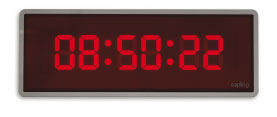Sapling’s Wireless Clock System – How Do Clocks Receive Time?
If I asked you what time it was, you could check your watch, the clock on your computer screen, or the timepiece on the wall in order to answer my question. Time is a constant in our lives and while we are always aware of it, have you ever wondered where clocks get the time from? At Sapling, we make it a priority to provide you with the most efficient and innovative clock systems. We offer a variety of timekeeping systems in order to meet the needs of a variety of organizations where knowing the correct time is crucial. We partner with such industries as education, healthcare, government, corporate and transportation, among many others.
Sapling’s wireless clock system is just that – wireless. They can be purchased in analog and digital. This system saves you time and money by eliminating the need to install wires throughout your entire facility. Don’t worry if you have an existing clock system. Sapling’s wireless clocks can be retrofitted to meet your needs.
So, since these clocks are wireless, how do they receive time?
When you install a Sapling wireless clock system, a master clock can receive time from two sources: an NTP server or a GPS Satellite. An NTP (Network Time Protocol) server is a reference time server used in a network for the management of precise time to various system devices. The server recognizes all NTP-capable devices that request a time source and ensures that the time is distributed correctly properly to each machine.
With your wireless clock system, you can also choose to receive time from a GPS satellite. Attached to the master clock is a GPS receiver which transmits its location to satellites that are orbiting the Earth. When the satellite obtains the signal, it sends the exact time to the GPS receiver which is located inside the master clock.
Now that you know how Sapling’s clocks receive time, how do the other wireless clocks in the system know what time it is? What’s unique about Sapling’s wireless clock system is that every clock acts as a repeater. For example, if a clock is out of range of the master clock’s signal, each secondary clock will be able to transmit the time to each other from multiple paths. This is called a mesh network and it gives you extra insurance that your clocks will always provide you with the most accurate time and allows for an unlimited amount of clocks to be connected to the system.
Because each wireless clock acts as a repeater, there is no need to purchase additional repeaters and transmitters, therefore saving you money and at the same time, providing you with the most accurate time possible.

